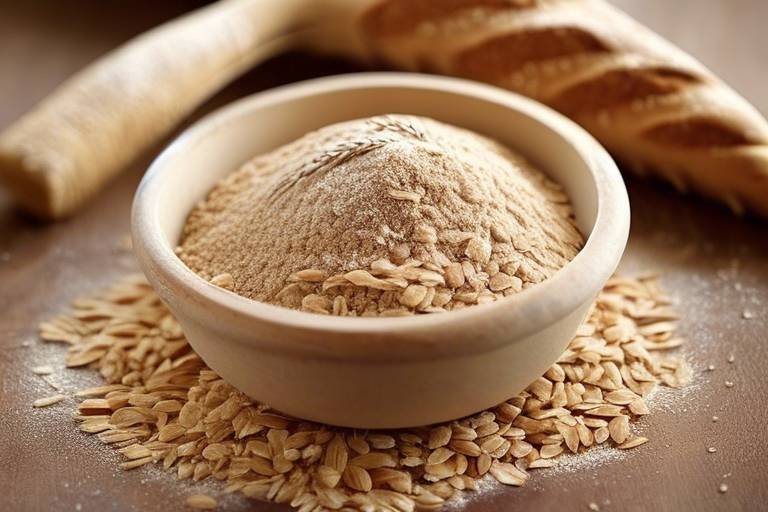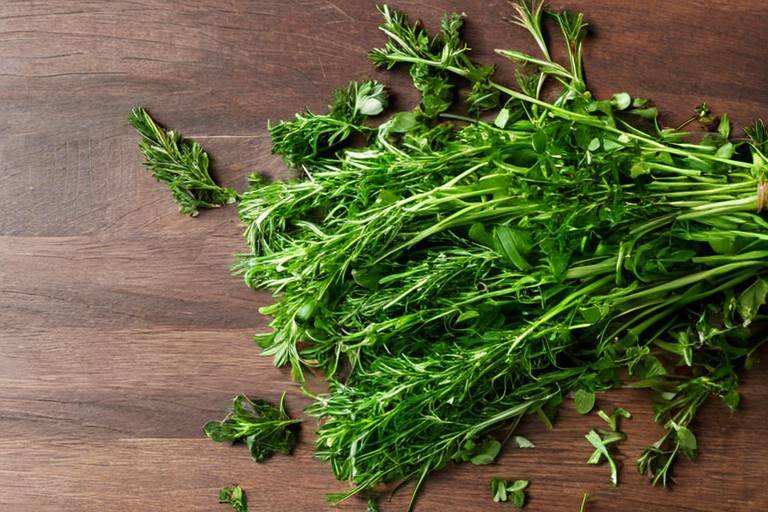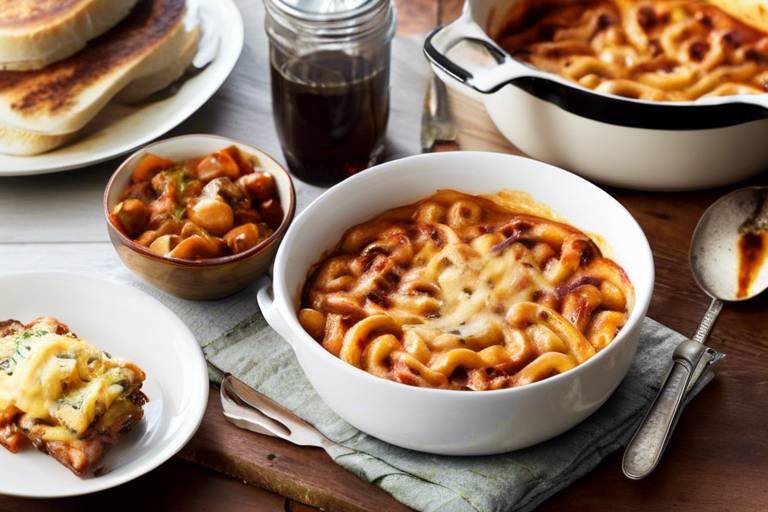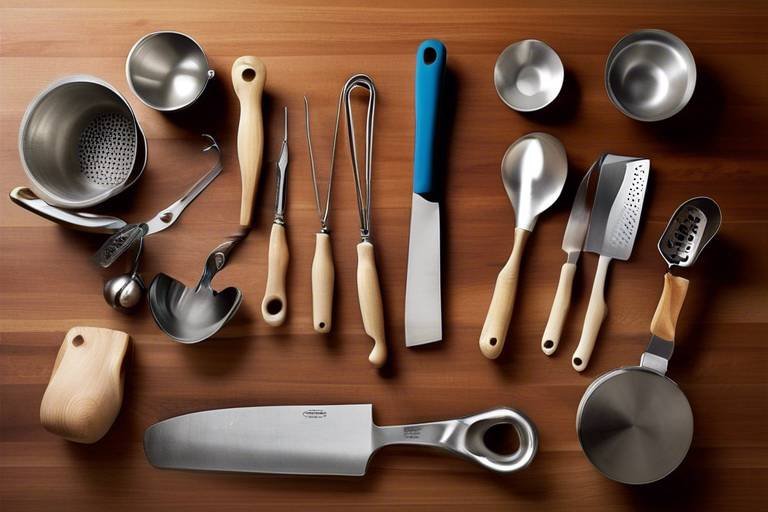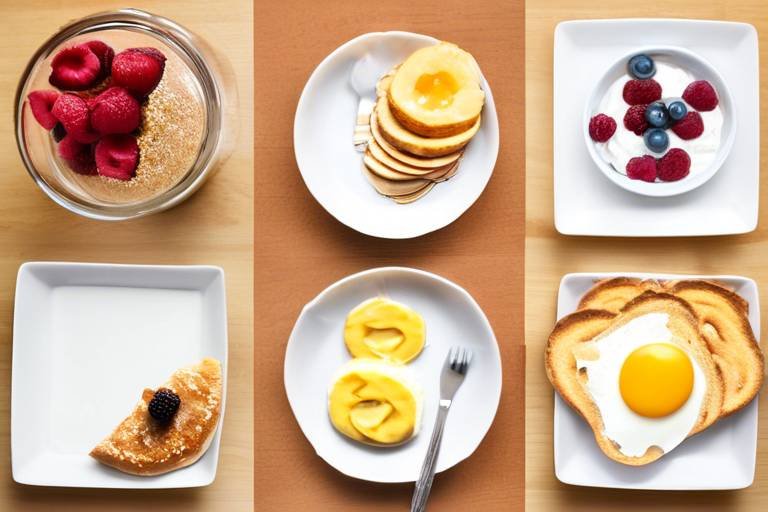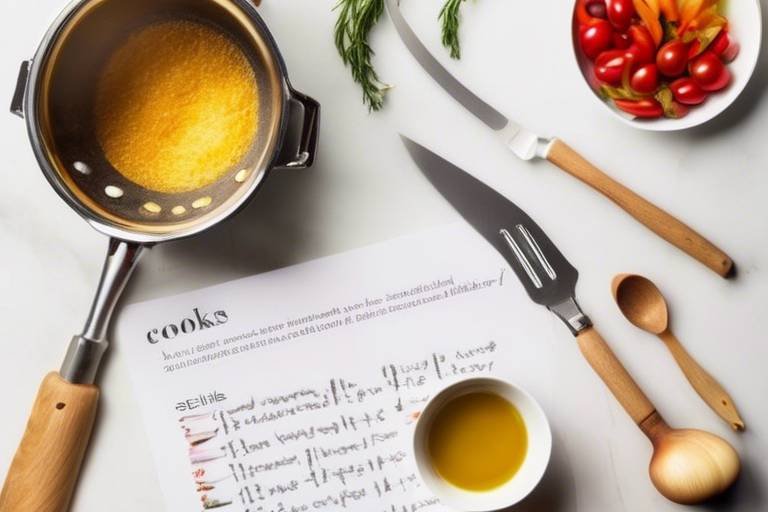Best Tips for Baking with Whole Wheat Flour
Are you ready to elevate your baking game with the wholesome goodness of whole wheat flour? Let's dive into some of the best tips that will help you master the art of baking with this nutritious ingredient.

Understanding Whole Wheat Flour
Discover how to successfully incorporate whole wheat flour into your baking recipes with these expert tips and tricks.
Whole wheat flour is a nutritious alternative to traditional all-purpose flour, offering a range of health benefits. Unlike refined flours, whole wheat flour is made by grinding the entire wheat kernel, including the bran and germ. This process retains valuable nutrients like fiber, vitamins, and minerals, making it a wholesome choice for baking. The inclusion of the bran and germ also gives whole wheat flour a slightly nutty flavor and a coarser texture compared to all-purpose flour.
Find out how to convert recipes that use all-purpose flour to whole wheat flour for healthier baking.
When using whole wheat flour in place of all-purpose flour, it's essential to adjust the liquid content in your recipes. Whole wheat flour absorbs more moisture than refined flours, so you may need to increase the amount of liquid to achieve the desired consistency in your batters or doughs.
Enhancing the texture and flavor of baked goods made with whole wheat flour can elevate your creations to new heights.
To maintain the moistness of whole wheat baked goods, consider incorporating moisture-rich ingredients like applesauce, yogurt, or mashed bananas into your recipes. These additions not only add flavor but also contribute to a softer, more tender crumb in your baked treats.
Proper mixing techniques are crucial when working with whole wheat flour to ensure even distribution of ingredients and optimal texture in your final product. Avoid overmixing to prevent gluten development, which can result in a dense or tough baked good.
Get inspired with delicious recipe ideas that showcase the versatility of whole wheat flour in baking.
Explore creative and tasty pastry recipes that highlight the use of whole wheat flour for healthier treats.

Conversion Tips
When it comes to converting recipes that traditionally use all-purpose flour to whole wheat flour, there are a few key tips to keep in mind to ensure successful results in your baking endeavors. Whole wheat flour has a different texture and flavor profile compared to all-purpose flour, so adjustments are necessary to achieve the desired outcome.
One important aspect to consider when converting recipes is the absorption of liquid by whole wheat flour. Due to its higher fiber content, whole wheat flour tends to absorb more moisture than all-purpose flour. This means you may need to increase the liquid content in your recipe to prevent the final product from becoming too dry or dense.
Additionally, the type of whole wheat flour you use can also impact the conversion process. There are different varieties of whole wheat flour available, such as white whole wheat flour and whole wheat pastry flour, each with its own characteristics. It's essential to choose the right type of whole wheat flour based on the recipe you are adapting to ensure the best results.
Experimenting with the ratio of whole wheat flour to all-purpose flour in a recipe can also help achieve the desired texture and flavor. Some bakers prefer to start by substituting a portion of the all-purpose flour with whole wheat flour and gradually increasing the ratio as they become more familiar with baking with whole wheat flour.
Furthermore, incorporating ingredients that add moisture, such as applesauce, yogurt, or mashed bananas, can help enhance the texture and moistness of baked goods made with whole wheat flour. These ingredients not only contribute to the overall flavor but also play a crucial role in maintaining the softness of the final product.
Overall, converting recipes to use whole wheat flour requires a bit of experimentation and adjustment to achieve the perfect balance of texture and flavor. By following these conversion tips and being open to exploring new techniques, you can elevate your baking skills and create delicious treats that are both nutritious and satisfying.

Adjusting Liquid Content
When it comes to baking with whole wheat flour, one crucial aspect to consider is adjusting the liquid content in your recipes. Whole wheat flour tends to absorb more liquid than all-purpose flour due to its higher fiber content. This means that you may need to increase the amount of liquid in your recipe to achieve the desired consistency.
One effective way to adjust the liquid content is to gradually add more liquid, such as water or milk, while mixing the batter. This allows you to control the consistency and prevent the batter from becoming too thick or dry. It's essential to strike the right balance to ensure your baked goods turn out moist and flavorful.
Additionally, you can also incorporate ingredients like yogurt, applesauce, or mashed bananas to add moisture to your recipes. These ingredients not only contribute to the texture of the baked goods but also enhance the flavor profile. Experimenting with different moisture-rich ingredients can lead to delicious results.
Moreover, consider the hydration level of your whole wheat flour when adjusting the liquid content. If you find that the flour absorbs more liquid than expected, don't hesitate to add a bit more to achieve the desired consistency. Remember, baking is a delicate balance of ingredients, and slight adjustments can make a significant difference in the final outcome.

Texture and Flavor Enhancements
When it comes to baking with whole wheat flour, there are several techniques you can use to enhance both the texture and flavor of your baked goods. Whole wheat flour has a nuttier and denser quality compared to all-purpose flour, so it's essential to make adjustments to achieve the desired results.
One way to enhance the texture of baked goods made with whole wheat flour is to incorporate ingredients that add moisture. Ingredients such as applesauce, mashed bananas, or yogurt not only provide moisture but also contribute to the overall flavor profile of the baked goods.
Additionally, mixing techniques play a crucial role in achieving the perfect texture when using whole wheat flour. Overmixing can result in a tough and dense final product, so it's important to mix the batter until just combined. This will help maintain a light and airy texture in your baked goods.
Furthermore, consider adding flavor enhancers such as vanilla extract, spices like cinnamon or nutmeg, or even citrus zest to complement the nuttiness of whole wheat flour. These additions can elevate the overall flavor profile of your baked treats and create a more dynamic taste experience.
Experimenting with different combinations of ingredients and techniques can lead to exciting and delicious results when baking with whole wheat flour. Whether you're making muffins, cookies, or bread, incorporating these texture and flavor enhancements can take your baked goods to the next level.

Adding Moisture-Rich Ingredients
When it comes to baking with whole wheat flour, incorporating moisture-rich ingredients is key to ensuring your baked goods turn out moist and delicious. Whole wheat flour has a tendency to absorb more liquid than all-purpose flour, which can result in drier baked goods if not adjusted properly. By adding ingredients that are rich in moisture, such as applesauce, mashed bananas, yogurt, or even buttermilk, you can help maintain the moistness of your baked treats.
These moisture-rich ingredients not only contribute to the texture of your baked goods but also add flavor and nutritional value. For example, using applesauce in place of some of the oil in a recipe can help reduce the fat content while keeping the final product moist. Similarly, incorporating mashed bananas not only adds natural sweetness but also provides moisture that can prevent the baked goods from becoming dry.
When experimenting with moisture-rich ingredients in your recipes, it's essential to consider their impact on the overall flavor profile. For instance, using yogurt in a recipe can add a tangy flavor that complements certain baked goods, while buttermilk can contribute a subtle tanginess and richness that enhances the taste of the final product.
To ensure the success of your baked goods when adding moisture-rich ingredients, it's important to adjust the overall liquid content of the recipe accordingly. Balancing the moisture from these ingredients with the other liquids in the recipe is crucial for achieving the desired texture and taste. Remember, the goal is to strike a harmonious balance that results in moist, flavorful baked goods that will delight your taste buds.

Mixing Techniques
When it comes to baking with whole wheat flour, mastering the is crucial for achieving the perfect texture and flavor in your baked goods. The way you mix your ingredients can significantly impact the final outcome of your recipes.
One essential mixing technique to keep in mind is to avoid overmixing the batter. Overmixing can lead to gluten development, resulting in a tough and dense final product. To prevent this, gently fold the ingredients together until just combined, ensuring a tender and light texture in your baked treats.
Another important aspect of is to alternate between adding dry and wet ingredients. This method helps to evenly distribute the ingredients and prevent clumping. Start by incorporating a portion of the dry ingredients, followed by a portion of the wet ingredients, and continue alternating until everything is well combined.
Additionally, consider the temperature of your ingredients when mixing with whole wheat flour. Using ingredients at room temperature allows for better incorporation and distribution of flavors, resulting in a more harmonious end product.
Experimenting with different such as the creaming method for cakes or the folding method for delicate batters can also elevate the overall quality of your baked goods. Each technique brings its unique characteristics to the final product, so don't be afraid to try new methods and see which works best for your recipes.

Recipe Ideas and Inspiration
When it comes to baking with whole wheat flour, the possibilities are endless, and the results can be truly delightful. Whole wheat flour adds a nutty flavor and hearty texture to baked goods, making them not only delicious but also healthier. If you're looking for some inspiration to get started on your whole wheat baking journey, we've got you covered with some exciting recipe ideas that will spark your creativity and tantalize your taste buds.
One excellent way to incorporate whole wheat flour into your baking is by making whole wheat banana bread. This classic recipe gets a nutritious twist with the addition of whole wheat flour, adding depth to the flavor and a satisfying chewiness to the texture. The natural sweetness of ripe bananas pairs perfectly with the nuttiness of the whole wheat flour, creating a wholesome treat that is perfect for breakfast or as a snack.
If you're in the mood for something a bit more indulgent, why not try your hand at baking whole wheat chocolate chip cookies? These cookies strike the perfect balance between decadent and nutritious, with the rich flavor of dark chocolate complementing the earthy notes of the whole wheat flour. Plus, the added fiber from the whole wheat flour makes these cookies a guilt-free indulgence that you can enjoy any time of day.
For those who prefer savory over sweet, whole wheat pizza dough is a fantastic recipe to experiment with. By using whole wheat flour in your pizza dough, you not only boost the nutritional value of your meal but also add a subtle complexity to the flavor profile. Top your whole wheat pizza crust with your favorite veggies and cheese for a wholesome and satisfying meal that is sure to please the whole family.
Looking to satisfy your sweet tooth without the guilt? Whole wheat carrot cake is the answer. This moist and flavorful cake is made even more delicious with the addition of whole wheat flour, which adds a rustic quality to the dessert. The warm spices and sweet carrots create a harmonious blend of flavors that will have you coming back for seconds.
When it comes to baking with whole wheat flour, the possibilities are truly endless. Whether you're in the mood for something sweet or savory, there are plenty of recipe ideas to explore that will showcase the versatility and deliciousness of whole wheat flour. So, roll up your sleeves, preheat your oven, and get ready to embark on a baking adventure that will surprise and delight your taste buds.

Whole Wheat Pastry Recipes
When it comes to baking with whole wheat flour, the possibilities are endless, especially when it comes to creating delicious and wholesome pastry recipes. Whole wheat flour adds a nutty flavor and hearty texture to pastries, making them a healthier alternative to traditional treats. With a few simple adjustments and creative ingredient choices, you can elevate your pastry game to a whole new level.
One popular whole wheat pastry recipe is the Whole Wheat Blueberry Muffins. These muffins are bursting with juicy blueberries and have a tender crumb that will leave you craving for more. By using whole wheat flour in this recipe, you not only increase the fiber content but also add a subtle depth of flavor that pairs perfectly with the sweetness of the blueberries.
To create a flaky and flavorful whole wheat pie crust, try incorporating whole wheat flour into your favorite pie crust recipe. The whole wheat flour adds a rustic touch to the crust while providing a slightly nutty taste that complements both sweet and savory fillings. Pair it with fresh fruit for a delightful dessert or fill it with savory ingredients for a hearty meal.
For a decadent treat, consider making Whole Wheat Chocolate Chip Cookies. These cookies are a crowd-pleaser with their chewy texture and rich chocolate flavor. The whole wheat flour adds a wholesome element to the cookies, making them a guilt-free indulgence that you can enjoy any time of day.
When experimenting with whole wheat flour in pastry recipes, don't be afraid to get creative and try new flavor combinations. Whether you're making scones, tarts, or cakes, whole wheat flour can add a unique twist to your favorite recipes while providing added nutritional benefits. So, roll up your sleeves, preheat your oven, and let your imagination run wild with whole wheat pastry recipes!
Frequently Asked Questions
- Can I substitute whole wheat flour for all-purpose flour in any recipe?
While you can substitute whole wheat flour for all-purpose flour in many recipes, it's important to note that whole wheat flour absorbs more liquid and has a denser texture. You may need to adjust the liquid content and possibly add more leavening agents to achieve the desired results.
- How can I make baked goods made with whole wheat flour more moist?
To enhance the moisture in baked goods made with whole wheat flour, consider adding moisture-rich ingredients such as yogurt, applesauce, or mashed bananas. These ingredients not only add moisture but also contribute to the flavor and texture of the final product.
- What are some tips for improving the flavor of whole wheat baked goods?
One way to enhance the flavor of whole wheat baked goods is to use ingredients like honey, maple syrup, or spices such as cinnamon and nutmeg. These additions can add depth and complexity to the flavor profile, making your baked goods more enjoyable.

